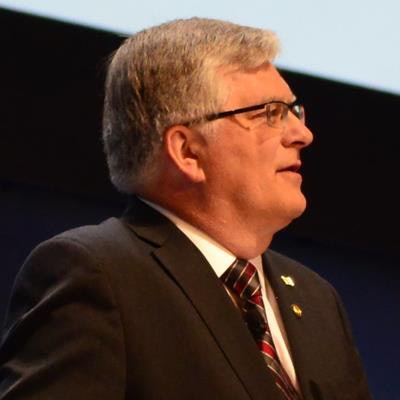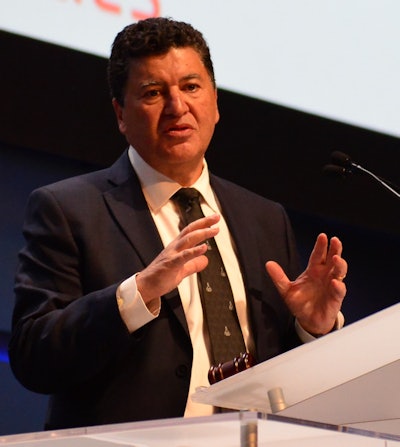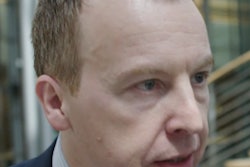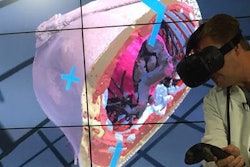
CHICAGO - Radiologists must be keen to explore, invent, and transform in a continuous effort to reinvent radiology. Indeed, it is now time for radiology to be proactive in advancing new technology to enhance the value of medicine, RSNA 2017 President Dr. Richard Ehman said in his opening address.
Advancements in machine learning, highly focused protocols, and value-focused engineering indicate improvements in effectively caring for patients in a new world of population-based care, Ehman said. Physicians will better serve patients when they use such advancements to provide them with access to medicine's highest capabilities.
"Imagine a world where our most powerful imaging technologies are widely available, high-value, and first-line diagnostic tools," he said. "Knowing that the disruption of our practice is inevitable, surely we must set out to establish our guidelines, instead of having our guidelines imposed upon us. This we can do through invention and reinvention."
Reinventing radiology
 RSNA 2017 President Dr. Richard Ehman.
RSNA 2017 President Dr. Richard Ehman.Physicians often consider the value of a diagnostic procedure as the ratio between quality, safety, and service of the procedure and its cost, according to Ehman, who is from the Mayo Clinic in Rochester, MN, and is a member of the Institute of Medicine (IOM). Advances in medical imaging science and technology have increased the numerator in this value equation.
"It was just a few decades ago that the main diagnostic option [for head trauma] would've been drilling burr holes through the skull in various locations to look for bleeding -- the same criminally invasive procedure of ancient times," he said. "We now take for granted that noninvasive imaging can quickly resolve this query."
Such changes in medical practice originate from singular discoveries, which is the case with radiology as a whole, he continued. Pioneers in radiology conducted early clinical studies using these discoveries and gradually deciphered information that went well beyond the initial invention -- a kind of reinvention.
Why is radiology uniquely suited to inspiring such practical innovation? Ehman pointed to several key characteristics of the field:
- Unique multidisciplinary teams: Medical imaging advances have almost always involved teamwork from multiple fields, including physics and medical science.
- Rapidly translated technology: It takes much longer for a discovery to become part of practice in other forms of medicine.
- Use-inspired strategy: Integrating basic and applied science from the onset has been hugely successful in the industrial world. "Radiologists are motivated by very practical problems, and they harness a synergy with basic science from the beginning of their work," Ehman said.
- Extraordinary returns: Medical science often yields an extraordinary return on investment, and radiology is leading the way. On average, a $1 investment in the U.S. National Institutes of Health (NIH) results in a $6 return to the economy, compared with a much higher $33 return when investing in the National Institute of Biomedical Imaging and Bioengineering (NIBIB).
"We still have a long way to go to tap the full potential of our science," Ehman said.
Radiologists can begin unleashing this potential by capitalizing on the unique strengths of the field, innovating relentlessly around value in medical imaging, and being open to innovation.
"Radiologists are fierce early adopters of new technology when they believe it can improve the quality of patient service," he said. "And if we don't embrace disruption, radiology will become a victim of intervention."
Promoting health longevity
Achieving health longevity for all -- one of the overarching goals of medicine -- is a grand challenge that highlights the need for continuous innovation, Dr. Roderic Pettigrew, PhD, former first director of NIBIB, told attendees in a special opening lecture titled "Tomorrow's Radiology."
 Dr. Roderic Pettigrew, PhD.
Dr. Roderic Pettigrew, PhD."This bold vision requires technological innovation for earlier precision and better diagnostic vision for therapeutics," he said.
A prime case of such innovation is conducting team healthcare through mixed reality, Pettigrew said. In one instance, a gastrointestinal physician in London consulted with a radiologist in Mumbai, India, and a scientist in Atlanta through a program that allowed them to collaborate virtually in the same room as avatars.
Other examples of recent technological innovation include a 4D motion compensation technique for mapping brain activity in utero despite irregular motion; a high-speed, high-resolution 3D gadolinium-based MRI approach for breast-conserving surgery; and fusion US and MRI to guide prostate lumpectomy in real-time.
Pivotal to this process will be the evolution and emergence of radiologists as imaging, information science, and image-guided therapeutics experts and active members in patient care, he said.
"Tomorrow's radiologist can use all of the images and physiologic data available in order to achieve health longevity," Pettigrew said. In the future, radiologists will be able to manage "this cockpit of integrated information as a valuable and indispensable member of healthcare teams."
Advancing biomedical imaging
Radiological innovation can move in numerous directions, but it is possible to predict the future of imaging innovation, said Dr. Elias Zerhouni in the final lecture of the opening session. Zerhouni formerly served as director of the NIH and is now the global head of research and development for the pharmaceutical company Sanofi.
 Dr. Elias Zerhouni.
Dr. Elias Zerhouni.There are three principles in determining the future of innovation:
- Much of the future's technology exists in the present: "What will be is already here," Zerhouni said.
- Imaging innovation is interdisciplinary: "Our roots come from various sources -- physics, chemistry, medicine -- and this cannot be forgotten," he said. "The question is: What other disciplines do you have to integrate into your body of science?"
- The future of innovation will stem from its unique traits: "Focus on what imaging can uniquely do," he said.
To remain relevant in the future, radiologists should seek out their role in elucidating the multidimensional network that makes up biomedicine, Zerhouni said. Importantly, radiologists need to work on understanding and managing the tension between complexity and precision, which involves accurately tracking the evolution of disease.
"In the future, the question will be: Who has the cleanest and best correlated data?" he said. "Who puts it together in a way that allows you to compare your patients in reference against data from other patients?"
With that goal in mind, radiologists should continue being key integrators in improving healthcare for patients through imaging, including building a global standard for aggregating all clinical imaging data, he said. They should also participate in solving the core scientific challenges of the day. Finally, radiologists need to support and train the next generation of radiological scientists.
Imagine if we could have a global reference for all human brain MRI studies, store them in the cloud, and provide neuroradiologists with relevant comparisons -- especially for diffuse brain diseases, he said. This would allow physicians to take a five-minute whole-body imaging scan of patients every few years, just like regular endoscopy or lab tests.
"Is this a pipe dream?" he asked. "Perhaps, but we've been surprised before."



















